The Millennium Development Goals (MDGSs) were perceived as a life line the United Nations and the rest of the world were throwing to Africa in order to save the continent from sinking.[i] The Millennium Development Goals was introduced in September 2000[ii] in the midst of the United Nations Millennium Declaration, and officially implemented in 2001.[iii] The purpose of these goals was to function as an outline for evaluating progress in development amongst independent states.[iv] Eight simple goals were formulated in the shape of the Millennium Development Goals, the purpose of these goals were to encourage social progress[v] by halving poverty, providing every child whether the child is a male or female access to primary education, facilitating the access of clean, drinking water and sanitation, the regression of environmental degradation, making health care more accessible, it specifically in the most infectious diseases such as HIV/AIDS and malaria. By providing health care treatment to these diseases, the goal will prevent the further spread of these diseases. The objective of these MDGs was to reach these goals in 2015.[vi] The MDGs are time bound and key aim is to improve human development in 2015.[vii]
Initially the MDGs were met with scepticism, especially when it was concerned about Africa.[viii] When it comes to fostering social progress in Africa, the situation is particularly sensitive, where weak macroeconomic performances of states are standard features in sub-Saharan.[ix] The African continent has been observed as possessing special needs when it comes to its Millennium Development Goals.[x] The idea of Africa being a case of “special needs”, instigates the notion that marginalises the continent on the scale of it being the disabled one that is incapable of helping itself, and that requires the assistance of others. Achieving MDGs in more specifically sub-Saharan Africa has been proven to be more complex than that of other regions.[xi]
Sub-Saharan Africa has the greatest need for Millennium Development Goal investments in the entire world.[xii] Sub-Saharan Africa is off-track with all the Millennium Development Goals.[xiii] Umaru Musa Yar’Adua, former president Nigeria, dually noted that the sheer number of risks involved in Africa’s target setting MDGs, were in stark contrast to that of any other independent state in the entire world.[xiv] This is because sub-Saharan Africa has been plagued with extremely high transport costs and small markets, low productivity of agriculture, extremely high disease misfortune, arbitrary bounders creating a long history of adverse geopolitics, and finally an extremely poor dispersion of technology from international markets.[xv] The maintenance and updating of the latest technologies to the continent have been very slow, especially when it comes to the uptake of agricultural and medical technologies, that plays crucial roles in the continent protecting itself from the spread of harmful diseases.[xvi]
“Africa… is the only continent not on track to meet any of the goals of the Millennium Declaration by 2015.” (UN World Summit Declaration, 2005).[xvii]
“iAnchorn Africa… the world is furthest behind in progress to fulfil {the MDGs}… Africa is well behind target on reaching all the goals.” (Blair Commission for Africa, 2005).[xviii]
“Sub-Saharan Africa, which at current trends will fall short of all the goals.” (p. xi, foreword by James Wolfensohn and Rodrigo de Rato, World Bank and IMF Global Monitoring Report, 2005).[xix]
“At the midway point between their adoption in 2000 and 2015 target date for achieving the MDGs, Sub-Saharan Africa us not on track to achieve any of the Goals.” (United Nations, Africa, & the Millennium Development Goals, 2007).[xx]
An Africa Progress Panel led by Kofi Annan was established to survey the G8’s commitment to Africa.[xxi] This Progress Panel was initiated at the half way mark of the Millennium Goals timeline of 2015, in order to fuel states to adhere to the goals it had set.[xxii] The Blair commission also anticipated that the Millennium Development Goals and the post-September 11 understanding of the link between poverty and national security would assist the mobilisation of increased financial resources towards Africa.[xxiii] According to Francis Nwonwu, continents and sub-continents to the likes of South America, Eastern Europe, and East, Central and Southeast Asia, have made sufficient improvements in their development, whilst Africa has found itself in this space of “development limbo”.[xxiv] Nwonwu blames the continent’s plague of political instability, poor governance, bloody civil wars and the various other forms of self-inflicting impairments for the continents poor progress in its Millennium Development Goals.[xxv]
1. Eradicate extreme poverty and hunger
Extreme poverty and hunger displays inconsistent levels in Africa, and have been proven to be deadly to the population.[xxvi] The vicious cycle of poverty leads to the detriment of sustainable development.[xxvii] The number of poverty stricken people increases in Africa with the increase in population, more specifically numbers in sub-Saharan Africa.[xxviii] In sub-Saharan Africa, people suffer from poor health due to HIV/AIDS and malaria, their lack of education and unemployment contributes to the inability to find means of increasing their income.[xxix] Another factor playing an enormous role in the poverty of sub-Saharan Africa is the depletion of resources, such as water, and political instability and corruption faced by numerous African states. All these factors play devastating roles in the hindering of economic growth of the continent.[xxx] Olusegun Obasanjo, the former president of Nigeria who was succeeded by Umaru Musa Yar’Adua, states that “Our quest for global peace and security will prove unsuccessful unless we intensify international cooperation for development and the reduction of poverty”.[xxxi] This statement reveals the harsh realities faced by African states in their long battle against poverty, and the manner in which African leaders are requesting assistance from the rest of the world speaks volumes to the inter-governance of the world.
Major factors that drives the vicious cycle of poverty in Africa are the numerous civil wars, those which have ceased and on-going; African states has also found that its poor socio-economic infrastructures and effects of globalisation have contributed to even greater poverty.[xxxii] Africa possesses limited access to international markets for African goods, this along with the denial of Non-Agricultural Market Access (NAMA), creates unfavourably high tariff conditions as well as unfavourable import and export environments.[xxxiii] Despite globalisation leading to good prospects for developed countries, African states have unfortunately not benefitted in the way that they ought to.[xxxiv] For globalisation has allowed for unrestricted, unmonitored access from developed countries into Africa, and allowed for the exploitation of Africa’s valuable resources.[xxxv]
34 of the 42 states listed as Heavily Indebted Poor Countries (HIPC) are found in Africa, which means that these states have no choice but to seek debt relief and debt-forgiveness.[xxxvi] According to Admos Chimhowu and David Hulme, in 2012 only nine out of the 48 states in sub-Saharan Africa seemed likely to meet their MDG of cutting the poverty stricken population in half.[xxxvii] Despite these numbers illustrating a dismal failure of the MDGs, these figures fail to illustrate the progress made by many African states.[xxxviii] The figures fail to showcase the percentage of the impoverished have decreased from 58% in 1990 to 51% in 2008.[xxxix] Even though sub-Saharan Africa will miss its target, because its speed of progress is too slow, progress was essentially made.[xl] Ghana and Uganda have been able to half their targets of impoverished people.[xli] Furthermore states such as Angola and Burkina Faso have been able to also make progress in its poverty targets, despite these states having undergone civil wars.[xlii] With Gambia reducing its poverty by 32% from the year 1990 till 2010, whilst Ethiopia reduced its poverty by a third, by means of concentrating on its agricultural and rural vocations.[xliii]
2. Achieve universal primary education
This Millennium Development Goal received major successes, with an 18% increase in primary education from 1999 to 2009, whilst states such as Gambia, Mali, Niger and Mozambique reporting more than 25% increases in universal primary education.[xliv] Sufficient progress was made in sub-Saharan Africa, concerning the goal at achieving universal primary education.[xlv] The region was able to allow 42 million additional children access to primary education institutions between the years 1999 and 2007.[xlvi] In 2007, the region boasted a 71% female enrolment in primary education institutions, and alarming increase from the mere 53% in 1999.[xlvii] Nonetheless these figures hid the failures of these states reaching their MDGs, for statistics shown points out that one in every fourth child in sub-Saharan Africa were not enrolled in any primary education institutions.[xlviii] What the initial figures failed to address is the high drop rate, as well as the inability to be proficient in writing, reading and calculating mathematical equations.[xlix] Statistics points out that a mere 63% of students who enrolled, would go on to actually complete the last grade of primary education.[l] African states such as Ethiopia, Zambia, Tanzania,[li] Algeria, Rwanda, São and Príncipe, Egypt, Morocco,[lii] Senegal, Uganda and Ghana[liii] have made remarkable successes in its effort to accomplish universal primary education. Despite numerous states making great leaps in its primary education statistics, another wave of problems surfaces from this positive MDG, that would include the quality of the education provided as well as the equity involved.[liv]
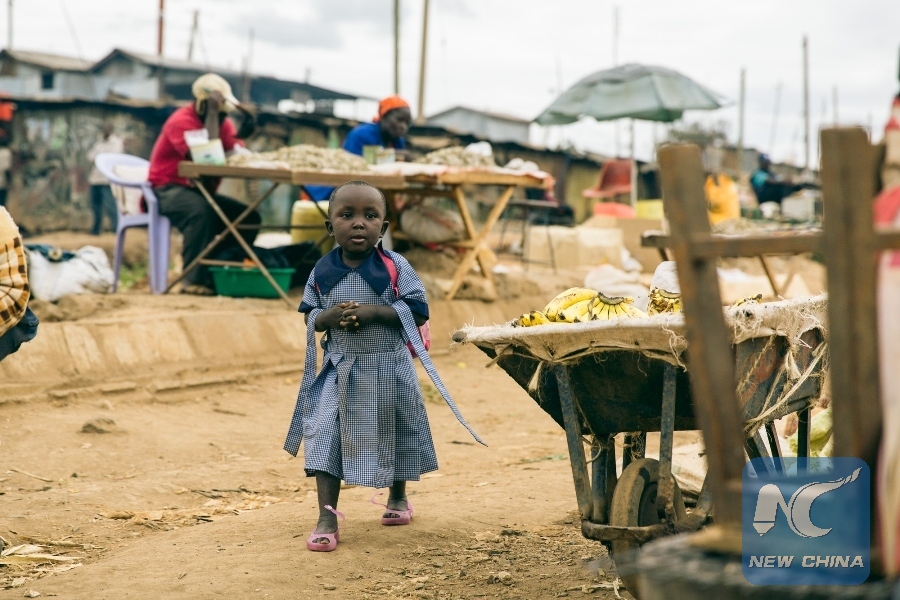 Young Kenyan girl walking home from school Image source
Young Kenyan girl walking home from school Image source
3. Promote gender equality and empower women
The main aim of the Millennium Development Goal is to abolish gender disparity to grant access for women into primary and secondary education.[lv] This MDG encourages women empowerment and female presence in the state’s parliamentary setting.[lvi] African states have been able to make diminutive progress when it comes to the female representation in the political sphere, nevertheless it cannot be ignored that female representation did increase even if it was only in a small numbers.[lvii] Woman empowerment and equality in the workplace, often speaks volumes to the general economic successes of the relevant state, as well as its environmental sustainability.[lviii] However in the case of African states, women often experience major restrictions in the prospect of them attempting to open a business, gaining admission to education, and becoming involved in local/national politics.[lix]
According to the former United Nations Secretary General, Kofi Anan, “When women thrive, all if society benefits, and succeeding generations are given a better start in life”, this speaks to the significant role that women play as the driving forces of socio-economic development.[lx] However, African women are still victims of harsh sexism and gender stereotypes, they will often not be paid for services rendered, whilst another 8/10 African women in the active workforce’s wages are not registered as formal wages.[lxi] Sub-Saharan Africa possesses shocking statistics surrounding the gender gap in primary school enrolment being the second largest in the world, whilst the region possesses the largest gender gap of secondary school enrolment.[lxii] In its efforts to reach gender equality, Niger’s School of Husbands conditioned men into becoming allies by means of educating men into understanding the female reproductive health system, family planning, and behavioural change guidance.[lxiii] States such as Rwanda, Gambia, Lesotho,[lxiv] Ghana, Mauritius, São Tomé and Príncipe[lxv] have shown significant progress on the front of promoting gender equality and empowering women.
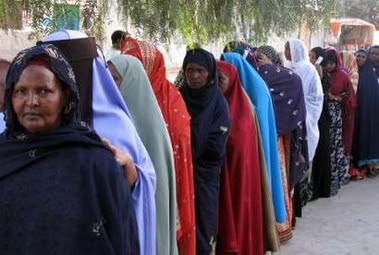 Somali women lining up to vote Image source
Somali women lining up to vote Image source
4. Reduce child mortality
Diminishing numbers have been experienced concerning the under-five mortality percentages in sub-Saharan Africa, since 1990.[lxvi] Statistics point out a reduction of 22% of the region’s under-five mortality rate.[lxvii] These progresses are largely a result of the increase in availability and general access to immunizations, as well as the increase in use of insecticide treated bed nets used to prevention measure against Malaria infection.[lxviii] Besides this progress sub-Saharan Africa are not nearly as close to the targets.[lxix] Sub-Saharan Africa recorded the highest rates of child mortality in 2008, these statistics comprised of 8.8 million casualties.[lxx] Unfortunately the region is also the only region where the rate of under-five mortality has been on the increase.[lxxi] Malaria, pneumonia, diarrhoea and HIV/Aids are the leading diseases which result in the mortality of children under the age of five.[lxxii] The odds are stacked against the African child, as a sub-Saharan African infant has a one-in-three chance of reaching the age of 65.[lxxiii] Despite interventions being induced to reduce the number of casualties, these interventions should be adapted to the specific state and target the under-five disease profile.[lxxiv] African states such as Niger, Ethiopia and Malawi[lxxv] have made noteworthy progress in their efforts at reducing child mortality in their respective states.
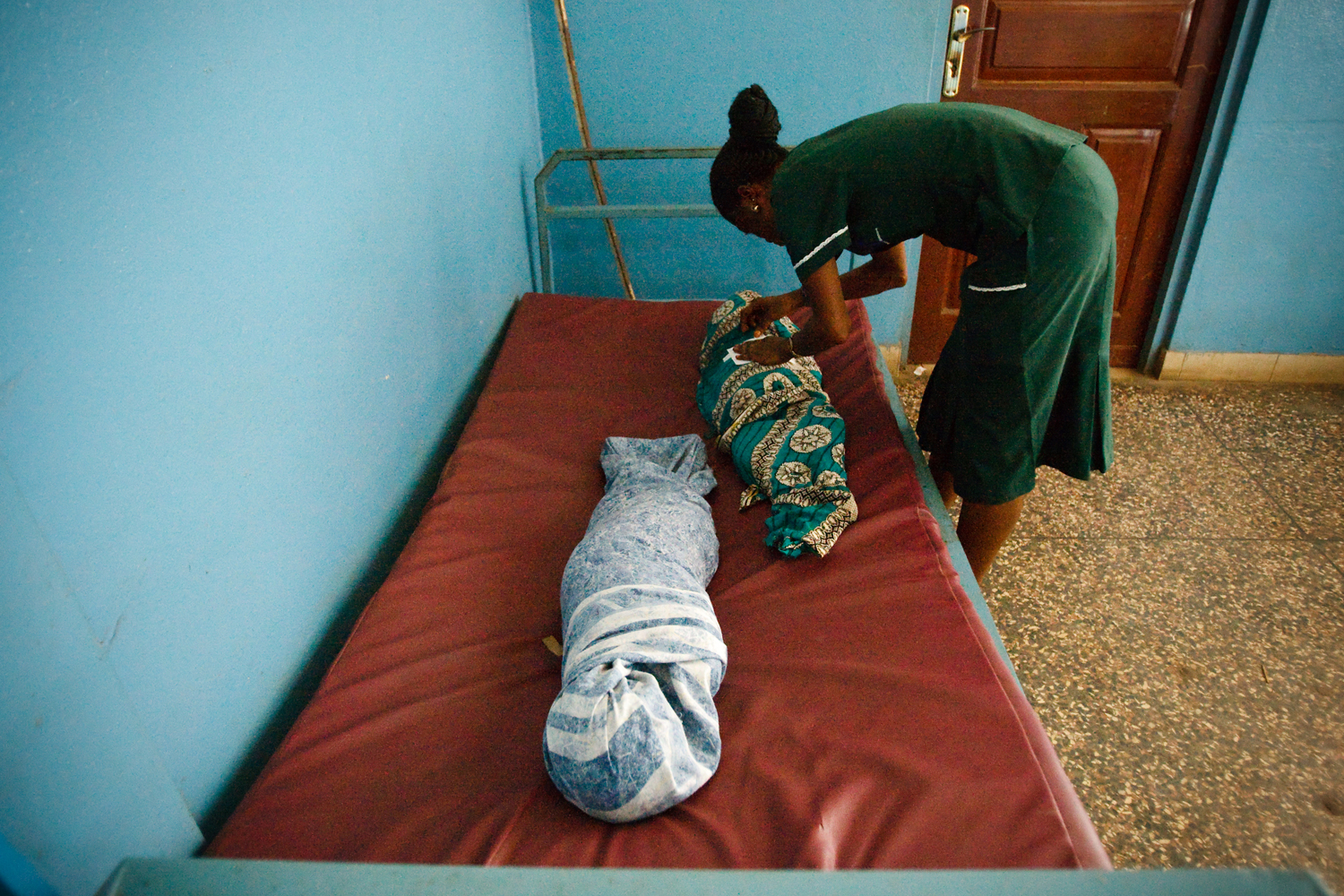 Infant deaths in a Sierra Leone hospital Image source
Infant deaths in a Sierra Leone hospital Image source
5. Improve maternal health
In sub-Saharan Africa, maternal mortality figures point out an increase in direct and indirect obstetrical causes. Nevertheless, when it comes to maternal health of women, sub-Saharan Africa made the least progress.[lxxvi] Reports reveal that 190 000 sub-Saharan African women die in pregnancy and through childbirth each year.[lxxvii] Studies also revealed that a mere half of all African women are provided with access to mid-wives.[lxxviii] In South Africa particularly, Aids has been the deadliest cause of most maternal deaths in the country, the early identification and proper health care management of the infected women will subsequently decrease the number of maternal deaths.[lxxix] The majority of sub-Saharan African states experienced a increase of maternal deaths, by means of Aids its main contributor, along with other deadly diseases.[lxxx] Whilst Egypt was able to half its maternal mortality rate in a mere eight year time frame.[lxxxi]
According to Bergstrom in Obstetric ectoscopy: an eye opener for hospital-based clinicians, [lxxxii] African states fail to provide sufficient numbers of hospitals that offer emergency obstetric services to pregnant women, fail to provide proper road and transport systems that would be permit to travel easily to hospitals and emergency obstetric services, and finally African states fail to provide a functional health care system, as many of its hospitals are not equipped, stocked and staffed with emergency obstetric services.[lxxxiii]
Furthermore Norton suggests that reproductive health can only be accomplished once its environment promotes gender equality, which encourages women to make independent decisions concerning the future of their reproductive systems.[lxxxiv] This means that women should have the power to dictate their use of contraception. However many African states possess gender restraints to this notion of safe sex, which means that emergency contraception and safe termination of pregnancy services are not often available to women.[lxxxv]
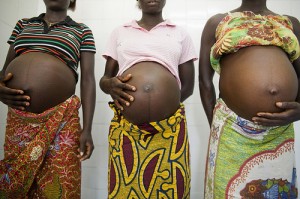 Pregnant women Image source
Pregnant women Image source
6. Combat HIV/AIDS, malaria and other diseases
The sheer masses of ill health on the African continent are incomparable to that of any continent.[lxxxvi] Diseases targeted by this Millennium Development Goal are that which worst affect sub-Saharan Africa, which is namely HIV/Aids, malaria and tuberculosis.[lxxxvii] International organisations such as the World Health Organisation (WHO) and the Global Fund for HIV/Aids, Tuberculosis and Malaria (GEATM) have worked tirelessly to alleviate the spread of these relevant diseases.[lxxxviii] Africa possesses more than 80% of the world’s HIV infected patients, whilst a further 26 million Africans have died as a result of AIDS.[lxxxix] The war against HIV/Aids and malaria have been met with significant successes, for instance in the region of 4 million Africans are currently receiving treatment, a drastic change from the initial 50 000 in the year 2002.[xc] A further 122 million bed nets were donated by the Global Fund, as a preventive measure against malaria.[xci] This effort contributed to the halving of malaria cases in a number of states.[xcii] Despite this momentous progress the health care systems in sub-Saharan Africa remain extremely poor and dawdling progress have been made to reduce the spread of HIV/Aids and tuberculosis.[xciii]
Nevertheless harsh realities still remain prevalent in sub-Saharan Africa, for even though there is decrease in the number of new HIV infection cases, the region has remained the worst infected region.[xciv] Statistics reveal that for every infected African placed on anti-retroviral treatment, another two Africans become infected with the deadly virus.[xcv] Uganda, Ethiopia, Rwanda,[xcvi] South Africa, Namibia, Zimbabwe and Côte d’Ivoire have made significant progress in their efforts to combat HIV/Aids, malaria and other diseases. Research suggests that in the case that South Africa attains its goal of combating HIV/Aids by the effective prevention of mother-to-child transmission of the virus, studies suggests that approximately 50 000 new born infants and children will be saved in 2015 alone.[xcvii]
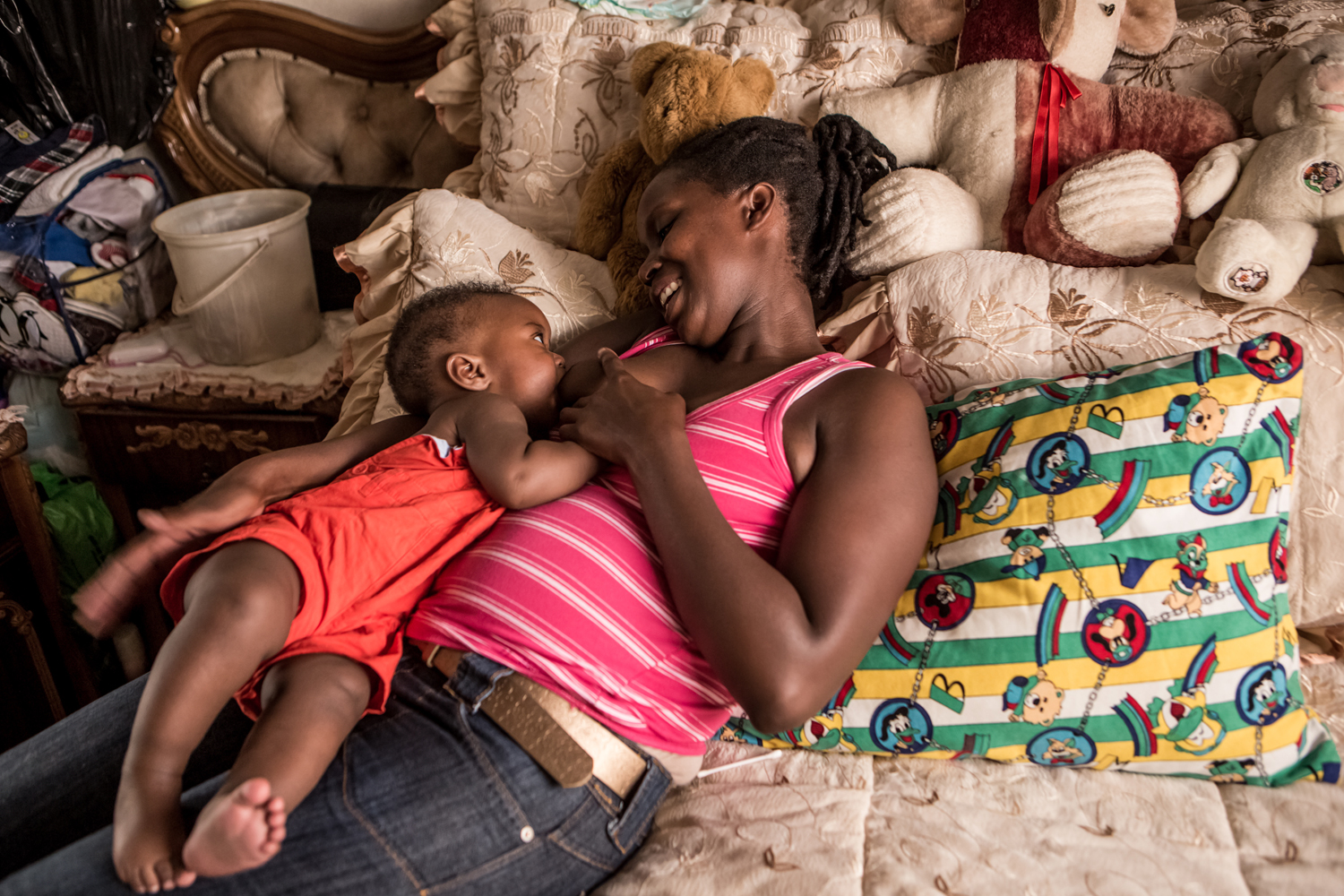 An HIV positive women, safely breastfeeding her infant in South Africa Image source
An HIV positive women, safely breastfeeding her infant in South Africa Image source
7. Ensure environmental stability
Africa is largely dependent on its primary agricultural sector, as well as exploitation of precious raw minerals such as diamonds and gold. With that being said, according to Sachs and others, the continent is in all essence living off its natural capital, a natural capital that will eventually be completely exhausted, a unfavourable and unfortunate circumstance for Africa.[xcviii] Evidently Africa is losing its natural losing its precious natural resources at a disturbingly fast rate.[xcix] Reports have indicated that Africa has eradicated 2,1% of its forests, this figure might seem marginal but it represents 5 million hectare of forests that have been destroyed between the years 1990 and 2000 alone.[c] The main causes of this loss have been the increase in population, along with a shifting cultivation system of farming techniques.[ci] This Millennium Development Goal considers sustainable development by means of implementing policies and programmes that considers its environmental impact as a priority.[cii] This includes the sustainable management of forestry resources, the preservation of biodiversity and genetic resources, the efficient use of energy, alleviating the detrimental effects greenhouse gases, which leads to global warming. Sub-Saharan Africa has experienced a slow and widely dispersed progress in increasing its people’s access to clean water and sanitation.[ciii] According to studies, 60% of sub-Saharan Africans have access to clean water, whilst a mere 31% are granted access to efficient sanitation.[civ]
Studies show that despite Africa not perhaps being the main culprit behind the devastating global warming, the continent will in fact be the worst affected by the climate changes that it has and will in due cause experience.[cv] African states such as Malawi, Burkina Faso, Ethiopia and Chad have made the most progress in ensuring the environmental stability of their respective states.[cvi] Whilst Cape Verde increased its state’s forest cover by over 6%, by means of planting millions of trees for the last couple of years.[cvii]
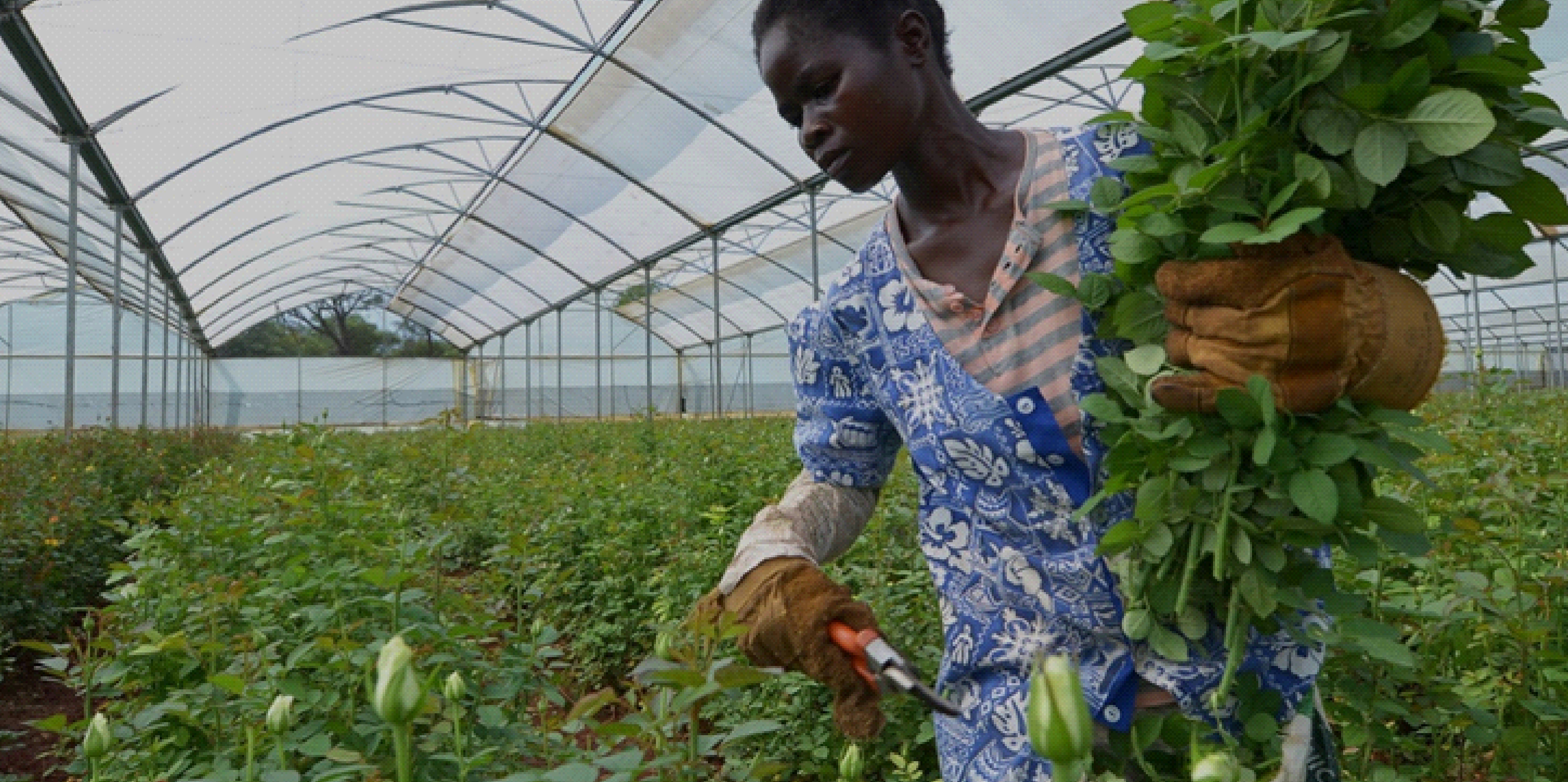 African women pruning roses in a greenhouse Image source
African women pruning roses in a greenhouse Image source
8. Development a global partnership for development
It is believed that in order to fully accomplish the first seven goals, states require the efficiency of the eighth goal, a development of global partnerships with the purpose of development as a priority.[cviii] This goal takes into account that in order for global partnerships to take place in a conducive environment, commitment and dedication is require from both developed and developing states.[cix] These global partnerships would include modifications being made to international trade agreements, trade capacity building and investment to prompt economic growth.[cx] Global partnerships however will only be successful when there is an improvement in governance of African states, civil society engagement, along with a culture of transparency often lacked by so many corrupt African states.[cxi] Only once all these conditions for development are met, will development and with the assurance of a continuous flow resource truly lead to progress in African states.[cxii]
Former president of Burkina Faso, Blaise Compaoré, reported in June 2003 at a World Trade Organisation meeting that there was a plight of West and Central African cotton-exporting states as a result of the developed states’ agricultural subsidies and the ultimate hypocrisy of trade rules and regulations, as well as structural adjustment reformations.[cxiii] Consequently these West and Central African states were forced to get rid of their agricultural subsidies, and their agricultural income was squashed, as a result of these “multiform subsidies”.[cxiv]
As a result of the lack of coherence between developed and developing states and the general absence of information concerning development partnership, this Millennium Development has not reached a definitive aspirations in the manner in which it ought to.[cxv] To illustrate this Craig Murphy states that “the average African will be responsible for more debt to the developed world in 2015 than her counterpart was in 2000”, he goes on to state that the average African will also experience similar or increasing international market barriers in the form of quotas and tariffs to the developed states’ markets.[cxvi]
Certain criticisms have been unveiled surrounding this Millennium Development Goal, as this goal represents the developed states presence in coincidently ambiguous terms, as it fails to properly stipulate the responsibilities of the developed states in providing the adequate and fair flow of aid, intellectual property rights and accessibility to trade markets.[cxvii] All these responsibilities play significant roles in the socio-economic progress of African states, [cxviii] and are to a certain degree almost intentionally neglected to benefit developed states.
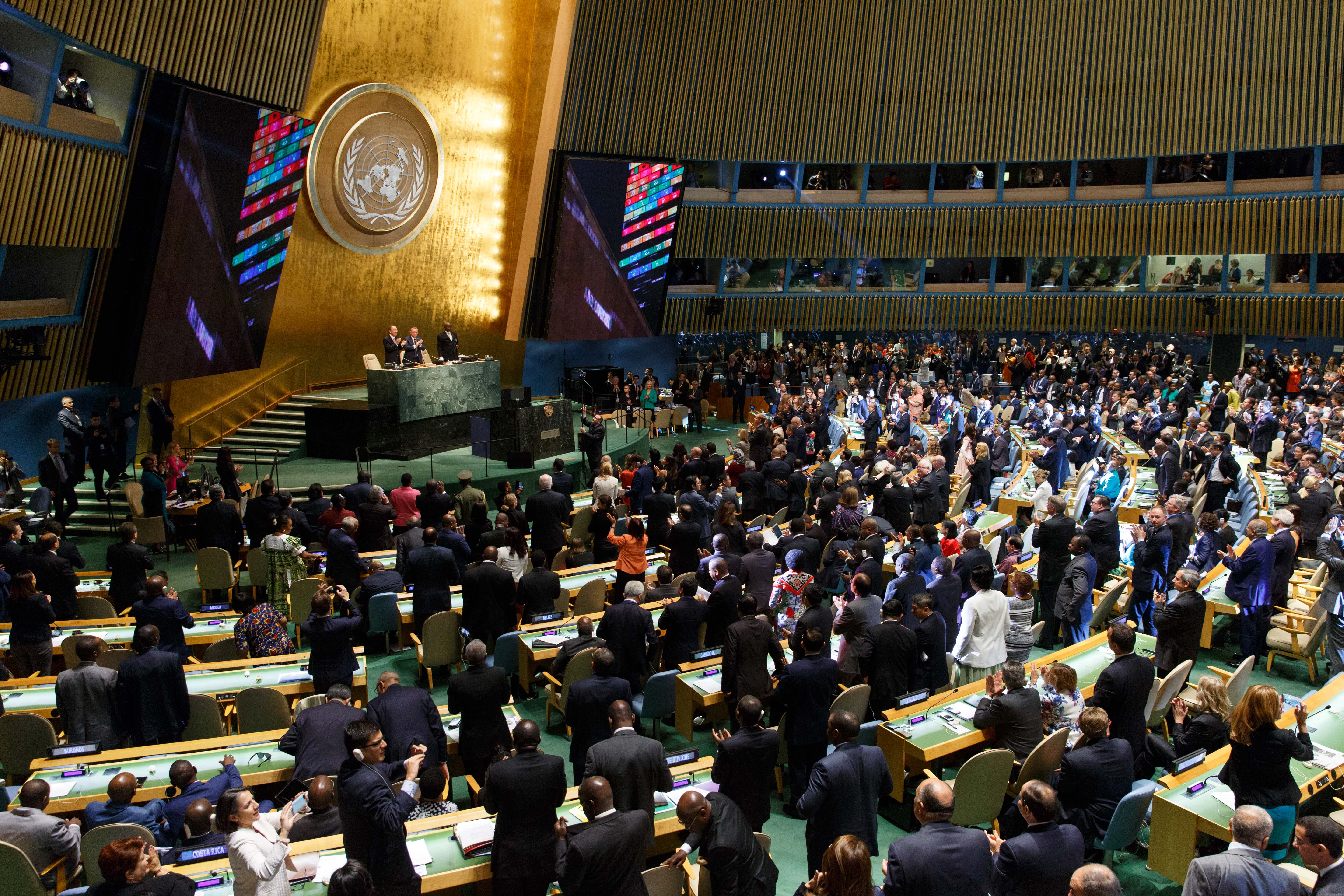 World leaders confederating to end poverty in 15 years through the use of United Nations goals, 2015 Image source
World leaders confederating to end poverty in 15 years through the use of United Nations goals, 2015 Image source
Conclusion
The Millennium Development Goals have positioned the African continent in a contradiction, for on the one hand it has failed to achieve its MDG targets, and on the other hand, it has accomplished the greatest socio-economic improvements in the spread of 15 years in the history of the continent.[cxix] The Overseas Development Institute (ODI) Report revealed the top achievers of MDGs included the likes of the following sub-Saharan states: Togo, Mali, Burkina Faso, Ethiopia, Ghana, Gambia, Uganda, Malawi and Mauritania.[cxx] Concerning states which made the least progress, often these states did not provide ODI with sufficient data to produce accurate readings; these states include Zimbabwe and Somalia.[cxxi] States such as Guinea-Bissau, Djibouti and Côte d’Ivoire have experienced poor economic growth patterns.[cxxii] Despite South Africa, Chad and Lesotho experiencing economic growth, their per capita figures dropped.[cxxiii] Stagnant economic growth often indicates a failed MDG.[cxxiv] The sub-Saharan African region failed to come close to reaching its MDGs.[cxxv] The region hosts 388 million impoverished, whilst a further 239 million experiencing hunger and starvation.[cxxvi] The impact of the 2008 world financial crisis further spiked these numbers, and worsened the conditions of the region.[cxxvii]
William Easterly suggests that the Millennium Development Goals set Africa up to portray the continent as a universal failure, despite a certain MDGs formulator protesting that the MDGs were meant to only be considered on a global scale, and was not concerned with a specific region in mind.[cxxviii] This MDGs formulator continued to condemn the biased demoralising treatment of publically labelling Africa as a Millennium Development Goal “failure”.[cxxix]
According to reports, the poor implementation of developmental mechanisms and the excessive reliance of development aid completely impeded upon the economic sustainability of Millennium Development Goals.[cxxx] The African continent made substantive progress with its Millennium Development Goals, despite not meeting their targets. Nevertheless the most recent initiation of the Sustainable Development Goals brings new aspirations and opportunities for the entire continent.[cxxxi] For through the MDG experience the continent can seek to overcome its challenges, and strategise resolutions that can be executed in the face of the Sustainable Development Goals.[cxxxii]
In retrospect, African states never really had any chance of achieving its Millennium Development Goals. For when deconstructing each MDG, one will find that each MDG are interlinked with one another, which means that for African states being far from reaching one MDG, will mean that it will absolutely not reach another MDG because MDG targets are often correlated.[cxxxiii]
Endnotes
[i] Nwonwu, F. (ed.). 2008. The Millennium Development Goals: achievements and prospects of meeting the targets in Africa. Pretoria: Africa Institute of South Africa, p. 1. ↵
[ii] The Millennium Development Goals [Online]. Available: http://www.un.org/en/mdg/summit2010/pdf/List%20of%20MDGs%20English.pdf ↵
[iii] Nwonwu, F. (ed.). 2008. The Millennium Development Goals: achievements and prospects of meeting the targets in Africa. Pretoria: Africa Institute of South Africa, p. 1. ↵
[iv] Nwonwu, F. (ed.). 2008. The Millennium Development Goals: achievements and prospects of meeting the targets in Africa. Pretoria: Africa Institute of South Africa, p. 1. ↵
[v] Sahn, D.E. & Stifel, D.C. 2003. “Progress toward the Millennium Development Goals in Africa,” World Development, 31(1): p. 23. ↵
[vi] Nwonwu, F. (ed.). 2008. The Millennium Development Goals: achievements and prospects of meeting the targets in Africa. Pretoria: Africa Institute of South Africa, p. 167. ↵
[vii] Nwonwu, F. (ed.). 2008. The Millennium Development Goals: achievements and prospects of meeting the targets in Africa. Pretoria: Africa Institute of South Africa, p.167. ↵
[viii] Wilkinson, R. & Hulme, D. (eds.) 2012. The Millennium Development Goals and Beyond: global development after 2015. Oxon, Routledge, p. 131. ↵
[ix] Sahn, D.E. & Stifel, D.C. 2003. “Progress toward the Millennium Development Goals in Africa,” World Development, 31(1): p. 23. ↵
[x] UN Millennium Project. 2005. Investing in Development: a practical plan to achieve the Millennium Goals. New York: Earthscan, p. 148. ↵
[xi] UN Millennium Project. 2005. Investing in Development: a practical plan to achieve the Millennium Goals. New York: Earthscan, p. 146. ↵
[xii] UN Millennium Project. 2005. Investing in Development: a practical plan to achieve the Millennium Goals. New York: Earthscan, p. 148. ↵
[xiii] Easterly, W. 2009. “How the Millennium Development Goals are unfair to Africa,” World Development, 37(1): p. 26. ↵
[xiv] Easterly, W. 2009. “How the Millennium Development Goals are unfair to Africa,” World Development, 37(1): p. 26. ↵
[xv] UN Millennium Project. 2005. Investing in Development: a practical plan to achieve the Millennium Goals. New York: Earthscan, p. 148. ↵
[xvi] UN Millennium Project. 2005. Investing in Development: a practical plan to achieve the Millennium Goals. New York: Earthscan, p. 152. ↵
[xvii] Easterly, W. 2009. “How the Millennium Development Goals are unfair to Africa,” World Development, 37(1): p. 26. ↵
[xviii] Easterly, W. 2009. “How the Millennium Development Goals are unfair to Africa,” World Development, 37(1): p. 26. ↵
[xix] Easterly, W. 2009. “How the Millennium Development Goals are unfair to Africa,” World Development, 37(1): p. 26. ↵
[xx] Easterly, W. 2009. “How the Millennium Development Goals are unfair to Africa,” World Development, 37(1): p. 26. ↵
[xxi] Joseph, R. & Gillies, A. 2009. Smart aid for African development. Boulder: Lynne Rienner Publishers, p. 57. ↵
[xxii] Joseph, R. & Gillies, A. 2009. Smart aid for African development. Boulder: Lynne Rienner Publishers, p. 57. ↵
[xxiii] Joseph, R. & Gillies, A. 2009. Smart aid for African development. Boulder: Lynne Rienner Publishers, p. 51. ↵
[xxiv] The Millennium Development Goals [Online]. Available: http://www.un.org/en/mdg/summit2010/pdf/List%20of%20MDGs%20English.pdf ↵
[xxv] The Millennium Development Goals [Online]. Available: http://www.un.org/en/mdg/summit2010/pdf/List%20of%20MDGs%20English.pdf ↵
[xxvi] Nwonwu, F. (ed.). 2008. The Millennium Development Goals: achievements and prospects of meeting the targets in Africa. Pretoria: Africa Institute of South Africa, p. 9. ↵
[xxvii] Nwonwu, F. (ed.). 2008. The Millennium Development Goals: achievements and prospects of meeting the targets in Africa. Pretoria: Africa Institute of South Africa, p. 9. ↵
[xxviii] Nwonwu, F. (ed.). 2008. The Millennium Development Goals: achievements and prospects of meeting the targets in Africa. Pretoria: Africa Institute of South Africa, p. 10. ↵
[xxix] Nwonwu, F. (ed.). 2008. The Millennium Development Goals: achievements and prospects of meeting the targets in Africa. Pretoria: Africa Institute of South Africa, p. 10. ↵
[xxx] Nwonwu, F. (ed.). 2008. The Millennium Development Goals: achievements and prospects of meeting the targets in Africa. Pretoria: Africa Institute of South Africa, p. 10. ↵
[xxxi] UNGA Disarmament Index 2004: H-R [Online]. Available: http://www.reachingcriticalwill.org/disarmament-fora/unga/2004/index/h-r ↵
[xxxii] Nwonwu, F. (ed.). 2008. The Millennium Development Goals: achievements and prospects of meeting the targets in Africa. Pretoria: Africa Institute of South Africa, p. 12. ↵
[xxxiii] Nwonwu, F. (ed.). 2008. The Millennium Development Goals: achievements and prospects of meeting the targets in Africa. Pretoria: Africa Institute of South Africa, p. 16. ↵
[xxxiv] Nwonwu, F. (ed.). 2008. The Millennium Development Goals: achievements and prospects of meeting the targets in Africa. Pretoria: Africa Institute of South Africa, p. 16. ↵
[xxxv] Nwonwu, F. (ed.). 2008. The Millennium Development Goals: achievements and prospects of meeting the targets in Africa. Pretoria: Africa Institute of South Africa, p. 16. ↵
[xxxvi] Nwonwu, F. (ed.). 2008. The Millennium Development Goals: achievements and prospects of meeting the targets in Africa. Pretoria: Africa Institute of South Africa, p. 273. ↵
[xxxvii] Wilkinson, R. & Hulme, D. (eds.) 2012. The Millennium Development Goals and Beyond: global development after 2015. Oxon: Routledge, p. 146 ↵
[xxxviii] Wilkinson, R. & Hulme, D. (eds.) 2012. The Millennium Development Goals and Beyond: global development after 2015. Oxon: Routledge, p. 146 ↵
[xxxix] Wilkinson, R. & Hulme, D. (eds.) 2012. The Millennium Development Goals and Beyond: global development after 2015. Oxon: Routledge, p.146 ↵
[xl] Wilkinson, R. & Hulme, D. (eds.) 2012. The Millennium Development Goals and Beyond: global development after 2015. Oxon: Routledge, p. 146 ↵
[xli] Wilkinson, R. & Hulme, D. (eds.) 2012. The Millennium Development Goals and Beyond: global development after 2015. Oxon: Routledge, p.147 ↵
[xlii] Wilkinson, R. & Hulme, D. (eds.) 2012. The Millennium Development Goals and Beyond: global development after 2015. Oxon: Routledge, p. 147 ↵
[xliii] MDG Progress Reports – Africa [Online]. Available: http://www.undp.org/content/undp/en/home/librarypage/mdg/mdg-reports/africa-collection.html ↵
[xliv] Wilkinson, R. & Hulme, D. (eds.) 2012. The Millennium Development Goals and Beyond: global development after 2015. Oxon: Routledge, p. 147 ↵
[xlv] Development Goals: how is Africa doing? [Online]. Available: http://www.one.org/us/policy/the-millennium-development-goals-how-is-africa-doing/ ↵
[xlvi] Development Goals: how is Africa doing? [Online]. Available: http://www.one.org/us/policy/the-millennium-development-goals-how-is-africa-doing/ ↵
[xlvii] Development Goals: how is Africa doing? [Online]. Available: http://www.one.org/us/policy/the-millennium-development-goals-how-is-africa-doing/ ↵
[xlviii] Development Goals: how is Africa doing? [Online]. Available: http://www.one.org/us/policy/the-millennium-development-goals-how-is-africa-doing/ ↵
[xlix] Development Goals: how is Africa doing? [Online]. Available: http://www.one.org/us/policy/the-millennium-development-goals-how-is-africa-doing/ ↵
[l] Development Goals: how is Africa doing? [Online]. Available: http://www.one.org/us/policy/the-millennium-development-goals-how-is-africa-doing/ ↵
[li] Development Goals: how is Africa doing? [Online]. Available: http://www.one.org/us/policy/the-millennium-development-goals-how-is-africa-doing/ ↵
[lii] Africa’s recent MDG performance [Online]. Available: http://www.afdb.org/en/topics-and-sectors/topics/millennium-development-goals-mdgs/africa%E2%80%99s-recent-mdg-performance/ ↵
[liii] Development Goals: how is Africa doing? [Online]. Available: http://www.one.org/us/policy/the-millennium-development-goals-how-is-africa-doing/ ↵
[liv] MDG Progress Reports – Africa [Online]. Available: http://www.undp.org/content/undp/en/home/librarypage/mdg/mdg-reports/africa-collection.html ↵
[lv] Nwonwu, F. (ed.). 2008. The Millennium Development Goals: achievements and prospects of meeting the targets in Africa. Pretoria: Africa Institute of South Africa, p. 77. ↵
[lvi] Nwonwu, F. (ed.). 2008. The Millennium Development Goals: achievements and prospects of meeting the targets in Africa. Pretoria: Africa Institute of South Africa, p. 77. ↵
[lvii] Development Goals: how is Africa doing? [Online]. Available: http://www.one.org/us/policy/the-millennium-development-goals-how-is-africa-doing/ ↵
[lviii] Nwonwu, F. (ed.). 2008. The Millennium Development Goals: achievements and prospects of meeting the targets in Africa. Pretoria: Africa Institute of South Africa, p. 77. ↵
[lix] Development Goals: how is Africa doing? [Online]. Available: http://www.one.org/us/policy/the-millennium-development-goals-how-is-africa-doing/ ↵
[lx] Nwonwu, F. (ed.). 2008. The Millennium Development Goals: achievements and prospects of meeting the targets in Africa. Pretoria: Africa Institute of South Africa, p. 274. ↵
[lxi] Development Goals: how is Africa doing? [Online]. Available: http://www.one.org/us/policy/the-millennium-development-goals-how-is-africa-doing/ ↵
[lxii] Development Goals: how is Africa doing? [Online]. Available: http://www.one.org/us/policy/the-millennium-development-goals-how-is-africa-doing/ ↵
[lxiii] MDG Progress Reports – Africa [Online]. Available: http://www.undp.org/content/undp/en/home/librarypage/mdg/mdg-reports/africa-collection.html ↵
[lxiv] Development Goals: how is Africa doing? [Online]. Available: http://www.one.org/us/policy/the-millennium-development-goals-how-is-africa-doing/ ↵
[lxv] Africa’s recent MDG performance [Online]. Available: http://www.afdb.org/en/topics-and-sectors/topics/millennium-development-goals-mdgs/africa%E2%80%99s-recent-mdg-performance/ ↵
[lxvi] Development Goals: how is Africa doing? [Online]. Available: http://www.one.org/us/policy/the-millennium-development-goals-how-is-africa-doing/ ↵
[lxvii] Development Goals: how is Africa doing? [Online]. Available: http://www.one.org/us/policy/the-millennium-development-goals-how-is-africa-doing/ ↵
[lxviii] Development Goals: how is Africa doing? [Online]. Available: http://www.one.org/us/policy/the-millennium-development-goals-how-is-africa-doing/ ↵
[lxix] Development Goals: how is Africa doing? [Online]. Available: http://www.one.org/us/policy/the-millennium-development-goals-how-is-africa-doing/ ↵
[lxx] Development Goals: how is Africa doing? [Online]. Available: http://www.one.org/us/policy/the-millennium-development-goals-how-is-africa-doing/ ↵
[lxxi] Development Goals: how is Africa doing? [Online]. Available: http://www.one.org/us/policy/the-millennium-development-goals-how-is-africa-doing/ ↵
[lxxii] Nwonwu, F. (ed.). 2008. The Millennium Development Goals: achievements and prospects of meeting the targets in Africa. Pretoria: Africa Institute of South Africa, p. 126. ↵
[lxxiii] UN Millennium Project. 2005. Investing in Development: a practical plan to achieve the Millennium Goals. New York: Earthscan, p. 6. ↵
[lxxiv] Nwonwu, F. (ed.). 2008. The Millennium Development Goals: achievements and prospects of meeting the targets in Africa. Pretoria: Africa Institute of South Africa, p. 126. ↵
[lxxv] Development Goals: how is Africa doing? [Online]. Available: http://www.one.org/us/policy/the-millennium-development-goals-how-is-africa-doing/ ↵
[lxxvi] Development Goals: how is Africa doing? [Online]. Available: http://www.one.org/us/policy/the-millennium-development-goals-how-is-africa-doing/ ↵
[lxxvii] Development Goals: how is Africa doing? [Online]. Available: http://www.one.org/us/policy/the-millennium-development-goals-how-is-africa-doing/ ↵
[lxxviii] Development Goals: how is Africa doing? [Online]. Available: http://www.one.org/us/policy/the-millennium-development-goals-how-is-africa-doing/ ↵
[lxxix] Nwonwu, F. (ed.). 2008. The Millennium Development Goals: achievements and prospects of meeting the targets in Africa. Pretoria: Africa Institute of South Africa, p. 166. ↵
[lxxx] Nwonwu, F. (ed.). 2008. The Millennium Development Goals: achievements and prospects of meeting the targets in Africa. Pretoria: Africa Institute of South Africa, p. 159. ↵
[lxxxi] Nwonwu, F. (ed.). 2008. The Millennium Development Goals: achievements and prospects of meeting the targets in Africa. Pretoria: Africa Institute of South Africa, p. 147. ↵
[lxxxii] Nwonwu, F. (ed.). 2008. The Millennium Development Goals: achievements and prospects of meeting the targets in Africa. Pretoria: Africa Institute of South Africa, p. 153 ↵
[lxxxiii] Nwonwu, F. (ed.). 2008. The Millennium Development Goals: achievements and prospects of meeting the targets in Africa. Pretoria: Africa Institute of South Africa, p. 153. ↵
[lxxxiv] Nwonwu, F. (ed.). 2008. The Millennium Development Goals: achievements and prospects of meeting the targets in Africa. Pretoria: Africa Institute of South Africa, p. 155. ↵
[lxxxv] Nwonwu, F. (ed.). 2008. The Millennium Development Goals: achievements and prospects of meeting the targets in Africa. Pretoria: Africa Institute of South Africa, p. 155. ↵
[lxxxvi] Nwonwu, F. (ed.). 2008. The Millennium Development Goals: achievements and prospects of meeting the targets in Africa. Pretoria: Africa Institute of South Africa, p. 168. ↵
[lxxxvii] Nwonwu, F. (ed.). 2008. The Millennium Development Goals: achievements and prospects of meeting the targets in Africa. Pretoria: Africa Institute of South Africa, p. 168. ↵
[lxxxviii] Nwonwu, F. (ed.). 2008. The Millennium Development Goals: achievements and prospects of meeting the targets in Africa. Pretoria: Africa Institute of South Africa, p. 168. ↵
[lxxxix] Nwonwu, F. (ed.). 2008. The Millennium Development Goals: achievements and prospects of meeting the targets in Africa. Pretoria: Africa Institute of South Africa, p. 168. ↵
[xc] Development Goals: how is Africa doing? [Online]. Available: http://www.one.org/us/policy/the-millennium-development-goals-how-is-africa-doing/ ↵
[xci] Development Goals: how is Africa doing? [Online]. Available: http://www.one.org/us/policy/the-millennium-development-goals-how-is-africa-doing/ ↵
[xcii] Development Goals: how is Africa doing? [Online]. Available: http://www.one.org/us/policy/the-millennium-development-goals-how-is-africa-doing/ ↵
[xciii] Development Goals: how is Africa doing? [Online]. Available: http://www.one.org/us/policy/the-millennium-development-goals-how-is-africa-doing/ ↵
[xciv] Development Goals: how is Africa doing? [Online]. Available: http://www.one.org/us/policy/the-millennium-development-goals-how-is-africa-doing/ ↵
[xcv] Development Goals: how is Africa doing? [Online]. Available: http://www.one.org/us/policy/the-millennium-development-goals-how-is-africa-doing/ ↵
[xcvi] Development Goals: how is Africa doing? [Online]. Available: http://www.one.org/us/policy/the-millennium-development-goals-how-is-africa-doing/ ↵
[xcvii] “Achieving the health Millennium Development Goals for South Africa: challenges and priorities,” Lancet, 374(1): p. 1028. ↵
[xcviii] UN Millennium Project. 2005. Investing in Development: a practical plan to achieve the Millennium Goals. New York: Earthscan, p. 148. ↵
[xcix] Nwonwu, F. (ed.). 2008. The Millennium Development Goals: achievements and prospects of meeting the targets in Africa. Pretoria: Africa Institute of South Africa, p. 275. ↵
[c] Nwonwu, F. (ed.). 2008. The Millennium Development Goals: achievements and prospects of meeting the targets in Africa. Pretoria: Africa Institute of South Africa, p. 275. ↵
[ci] Nwonwu, F. (ed.). 2008. The Millennium Development Goals: achievements and prospects of meeting the targets in Africa. Pretoria: Africa Institute of South Africa, p. 275. ↵
[cii] Nwonwu, F. (ed.). 2008. The Millennium Development Goals: achievements and prospects of meeting the targets in Africa. Pretoria: Africa Institute of South Africa, p. 210. ↵
[ciii] Development Goals: how is Africa doing? [Online]. Available: http://www.one.org/us/policy/the-millennium-development-goals-how-is-africa-doing/ ↵
[civ] Development Goals: how is Africa doing? [Online]. Available: http://www.one.org/us/policy/the-millennium-development-goals-how-is-africa-doing/ ↵
[cv] Development Goals: how is Africa doing? [Online]. Available: http://www.one.org/us/policy/the-millennium-development-goals-how-is-africa-doing/ ↵
[cvi] Development Goals: how is Africa doing? [Online]. Available: http://www.one.org/us/policy/the-millennium-development-goals-how-is-africa-doing/ ↵
[cvii] MDG Progress Reports – Africa [Online]. Available: http://www.undp.org/content/undp/en/home/librarypage/mdg/mdg-reports/africa-collection.html ↵
[cviii] Development Goals: how is Africa doing? [Online]. Available: http://www.one.org/us/policy/the-millennium-development-goals-how-is-africa-doing/ ↵
[cix] Development Goals: how is Africa doing? [Online]. Available: http://www.one.org/us/policy/the-millennium-development-goals-how-is-africa-doing/ ↵
[cx] Development Goals: how is Africa doing? [Online]. Available: http://www.one.org/us/policy/the-millennium-development-goals-how-is-africa-doing/ ↵
[cxi] Development Goals: how is Africa doing? [Online]. Available: http://www.one.org/us/policy/the-millennium-development-goals-how-is-africa-doing/ ↵
[cxii] Development Goals: how is Africa doing? [Online]. Available: http://www.one.org/us/policy/the-millennium-development-goals-how-is-africa-doing/ ↵
[cxiii] Cheru, F. & Bradford, C. (eds.). 2005. The Millennium Development Goals: raising the resources to tackle world poverty. London: Zed Books Ltd., p. 103. ↵
[cxiv] Cheru, F. & Bradford, C. (eds.). 2005. The Millennium Development Goals: raising the resources to tackle world poverty. London: Zed Books Ltd., p. 103. ↵
[cxv] Wilkinson, R. & Hulme, D. (eds.) 2012. The Millennium Development Goals and Beyond: global development after 2015. Oxon: Routledge, p. 135 ↵
[cxvi] Wilkinson, R. & Hulme, D. (eds.) 2012. The Millennium Development Goals and Beyond: global development after 2015. Oxon: Routledge, p. 135 ↵
[cxvii] Wilkinson, R. & Hulme, D. (eds.) 2012. The Millennium Development Goals and Beyond: global development after 2015. Oxon: Routledge, p. 170 ↵
[cxviii] Wilkinson, R. & Hulme, D. (eds.) 2012. The Millennium Development Goals and Beyond: global development after 2015. Oxon: Routledge, p. 170. ↵
[cxix] Wilkinson, R. & Hulme, D. (eds.) 2012. The Millennium Development Goals and Beyond: global development after 2015. Oxon: Routledge, p. 156. ↵
[cxx] Wilkinson, R. & Hulme, D. (eds.) 2012. The Millennium Development Goals and Beyond: global development after 2015. Oxon: Routledge, p. 160. ↵
[cxxi] Wilkinson, R. & Hulme, D. (eds.) 2012. The Millennium Development Goals and Beyond: global development after 2015. Oxon: Routledge, p. 160. ↵
[cxxii] Wilkinson, R. & Hulme, D. (eds.) 2012. The Millennium Development Goals and Beyond: global development after 2015. Oxon: Routledge, p. 160. ↵
[cxxiii] Wilkinson, R. & Hulme, D. (eds.) 2012. The Millennium Development Goals and Beyond: global development after 2015. Oxon: Routledge, p. 162. ↵
[cxxiv] Wilkinson, R. & Hulme, D. (eds.) 2012. The Millennium Development Goals and Beyond: global development after 2015. Oxon: Routledge, p. 162. ↵
[cxxv] Development Goals: how is Africa doing? [Online]. Available: http://www.one.org/us/policy/the-millennium-development-goals-how-is-africa-doing/ ↵
[cxxvi] Development Goals: how is Africa doing? [Online]. Available: http://www.one.org/us/policy/the-millennium-development-goals-how-is-africa-doing/ ↵
[cxxvii] Development Goals: how is Africa doing? [Online]. Available: http://www.one.org/us/policy/the-millennium-development-goals-how-is-africa-doing/ ↵
[cxxviii] Easterly, W. 2009. “How the Millennium Development Goals are unfair to Africa,” World Development, 37(1): p. 34. ↵
[cxxix] Easterly, W. 2009. “How the Millennium Development Goals are unfair to Africa,” World Development, 37(1): p. 34. ↵
[cxxx] MDG Progress Reports – Africa [Online]. Available: http://www.undp.org/content/undp/en/home/librarypage/mdg/mdg-reports/africa-collection.html ↵
[cxxxi] MDG Progress Reports – Africa [Online]. Available: http://www.undp.org/content/undp/en/home/librarypage/mdg/mdg-reports/africa-collection.html ↵
[cxxxii] MDG Progress Reports – Africa [Online]. Available: http://www.undp.org/content/undp/en/home/librarypage/mdg/mdg-reports/africa-collection.html ↵
[cxxxiii] Easterly, W. 2009. “How the Millennium Development Goals are unfair to Africa,” World Development, 37(1): p. 30. ↵